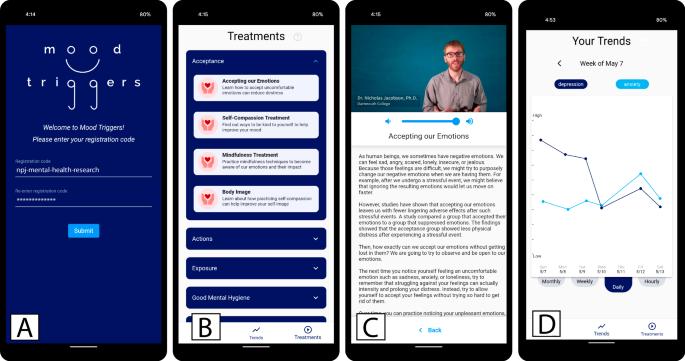Evaluating a mobile app’s effects on depression and anxiety in medication-treated opioid use disorder
引用次数: 0
Abstract
Depression and anxiety frequently co-occur with opioid use disorder (OUD) yet are often overlooked in standard OUD treatments. This study evaluated the feasibility, acceptability, and preliminary effectiveness of a mobile application designed to address these symptoms in individuals receiving medications for OUD (MOUD). A randomized controlled trial recruited N = 63 adults with OUD who received MOUD and screened positive for moderate depression or generalized anxiety. Participants were randomized to an app-based digital intervention or treatment-as-usual for 4 weeks, and completed follow-ups at 4 and 8 weeks. Primary outcomes were self-reported severity measures for depression and generalized anxiety, and urine drug screens (UDS). Secondary outcomes included self-reported OUD severity, craving intensity, and digital biomarkers derived from passive smartphone sensors. The application was well-received (median app rating = 4/5 stars). The intervention group showed significant reductions in depressive and generalized anxiety symptoms post-intervention and at 8 weeks follow-up (d > 0.70), with large (d = 0.78) and moderate (d = 0.38) effect sizes, respectively, compared to controls. Both groups exhibited substantial decreases in self-reported severity of opioid use symptoms (d > 2.50). UDS suggested similar between-group adherence to MOUD, with a marginal decrease in opioid (MOP) use in the intervention group and increase in controls, yielding medium between group effect sizes (d = 0.44). Passive sensor data suggested significant increases in social connectedness in the intervention group, evidenced by a significant rise in incoming and outgoing calls and text connections. Initial evidence supports the feasibility and acceptability of a digital intervention for treating anxiety and depressive symptoms in persons receiving MOUD. While underpowered to confidently determine statistical significance beyond directionality, the intervention showed promise in reducing depressive and anxiety symptoms, suggesting its potential as a cost-effective and scalable adjunctive therapy alongside standard OUD treatment. Due to the preliminary nature of this pilot study, further research with sample sizes permitting greater statistical power is needed to confirm findings and explore long-term effects.

评估手机应用对药物治疗阿片类药物使用障碍患者抑郁和焦虑的影响
抑郁和焦虑经常与阿片类药物使用障碍(OUD)并发,但在标准的 OUD 治疗中却常常被忽视。本研究评估了一款移动应用程序的可行性、可接受性和初步有效性,该应用程序旨在解决接受药物治疗的阿片类药物使用障碍(OUD)患者的这些症状。随机对照试验招募了 N = 63 名接受 MOUD 并筛查出中度抑郁或广泛焦虑的成人 OUD 患者。参与者被随机分配接受为期 4 周的基于应用程序的数字干预或常规治疗,并在 4 周和 8 周时完成随访。主要结果是自我报告的抑郁和广泛焦虑严重程度测量值以及尿液药物筛查(UDS)。次要结果包括自我报告的 OUD 严重程度、渴求强度以及从被动智能手机传感器获得的数字生物标志物。该应用程序广受欢迎(应用程序评分中位数 = 4/5 星)。与对照组相比,干预组在干预后和随访 8 周时抑郁症状和广泛焦虑症状明显减轻(d > 0.70),效应大小分别为较大(d = 0.78)和中等(d = 0.38)。两组患者自我报告的阿片类药物使用症状严重程度都有大幅下降(d = 2.50)。UDS 表明组间对 MOUD 的坚持程度相似,干预组的阿片类药物(MOP)使用量略有减少,而对照组则有所增加,组间效应大小为中等(d = 0.44)。被动传感器数据表明,干预组的社交联系明显增加,这体现在来往电话和短信联系显著增加。初步证据表明,通过数字干预治疗肢端残疾患者的焦虑和抑郁症状具有可行性和可接受性。虽然干预措施的力度不足,无法确定除方向性以外的统计学意义,但它在减轻抑郁和焦虑症状方面显示出了前景,表明它有可能成为一种具有成本效益和可推广性的辅助疗法,与标准的 OUD 治疗一起使用。由于这项试验性研究的初步性质,还需要进一步的研究,其样本量应允许更大的统计能力,以确认研究结果并探索长期效果。
本文章由计算机程序翻译,如有差异,请以英文原文为准。
求助全文
约1分钟内获得全文
求助全文

 求助内容:
求助内容: 应助结果提醒方式:
应助结果提醒方式:


